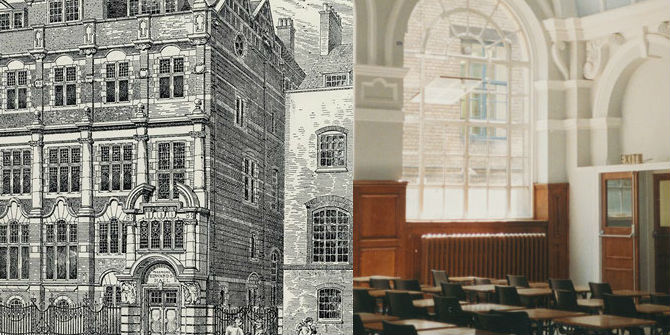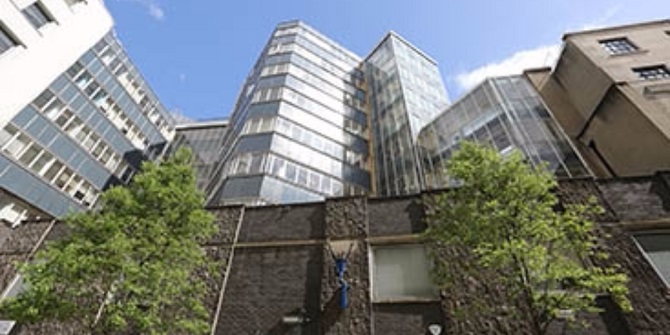The Old Curiosity Shop stands out on LSE’s modern campus as the oldest surviving building in the area, writes Mhairi Gowans. When did the Old Curiosity Shop get its name and is it really linked to Charles Dickens’ famous novel?
Built in 1567, the Old Curiosity Shop predates the founding of Clare Market, the development of Houghton Street, and the grand buildings of Lincoln’s Inn Fields – and the novel of the same name.
But the ‘Old Curiosity Shop’ is doomed. At some not very remote period the traffic will be rolling over its site and London will know it no more.
– Pall Mall Gazette, 1 January 1884
Its origins and use are unknown, though it is believed to have once been a dairy on the neighbouring estate of Louise de Kérouaille, Duchess of Portsmouth – a mistress of Charles II – from which Portsmouth Street gets its name. When first built, the Old Curiosity Shop would have been surrounded by fields – the open expanse of Lincoln Inn Fields to its north, the yet undeveloped Clement’s Inn Fields to its south, and the fields of St Giles to its west.
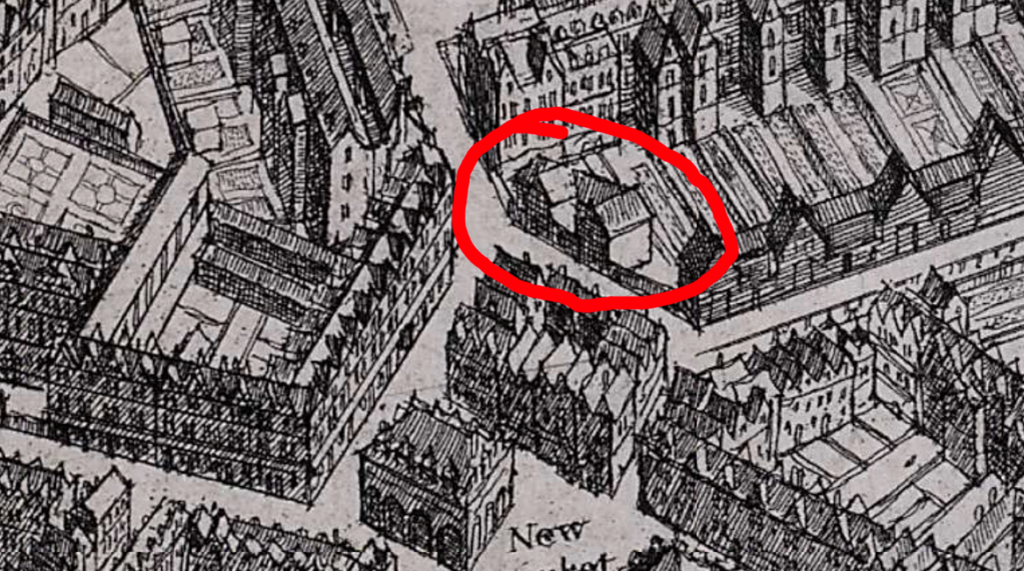
Clement’s Lane, from being the polished abode of wit, genius and fashion was converted by the ruthless hand of time into a huge overcrowded den.
– John Diprose, Some Account of the Parish of Saint Clement Danes, 1868
Development over the next 200 years meant that by the 1800s the Old Curiosity Shop was ensconced within the overcrowded and poverty-stricken area of Clare Market. The shop was occupied through these decades by a revolving door of different tradesmen. In the 1851 census, 10 years after the publication of Charles Dickens’ book, the Old Curiosity Shop was occupied by the shoemaker John Frith, his wife, two daughters and son. Ten years later and it was in the hands of Bernard Boden, a tailor from Dublin, his wife Harriet who was an umbrella maker, and Julia Guns who was Harriet’s assistant.
Here are old shops with their cracked dusty windows and repellent interiors, blocked up with what is custom to call ‘bric-à-brac.’ And here may be seen men, women and children who would gladly sit as models of low life to the next novelist in search of a character.
– Pall Mall Gazette, 1 January 1884
Becoming the Old Curiosity Shop
It was in the 1870s that a big change occurred in the fortunes of our Old Curiosity Shop, for it was in this decade that it came to be known by that name. The tenant at this time was Barnabus Tesseyman who ran it as a bookshop with his wife Catherine. According to his brother Charles, Barnabus painted the legend on the wall with the hope it would drum up more business. Before this, no connection had ever been made between the shop and the book. When Barnabus died, the new tenant, a waste-paper merchant named Horace Poole, kept the name. Charles later explained in the press that a visiting American writer saw the inscription and wrote an article in Scribner’s Monthly declaring the shop as the one from the Dickens story.
Tesseyman’s whole store of books was never worth five shillings altogether; it was the shabbiest collection of insignificant odd volumes, in the raggedest and dirtiest condition, to be found all over London.
– The Illustrated London News, 5 January 1884
Thus, when the building was announced to be in structural danger and was to be demolished during the Christmas of 1883, it was flooded with sightseers hoping to see the building where Little Nell supposedly once lived. Artists sat in the street to paint it and American tourists flocked to it.
’And one well-dressed person,’ said my hostess, with a sniff of contempt, ‘asked me if he might take a brick away with him as a relic.’ “I will smooth it down, and it shall be an heirloom in my family forever.” A lunatic, I call him.’
– Shields Daily Gazette, 4 January 1884
The Liverpool Echo from January 1884 records that people took their hats off as they entered and women would get on their knees and cry. The American actress Mary Anderson gave the Poole’s free admittance to the Lyceum Theatre as long as she performed there. Perhaps due to the fuss over the building, the Old Curiosity Shop survived this threat of demolition and the Poole’s made good use of the connection in the advertisements they took out in the Public Ledger And Daily Advertiser.
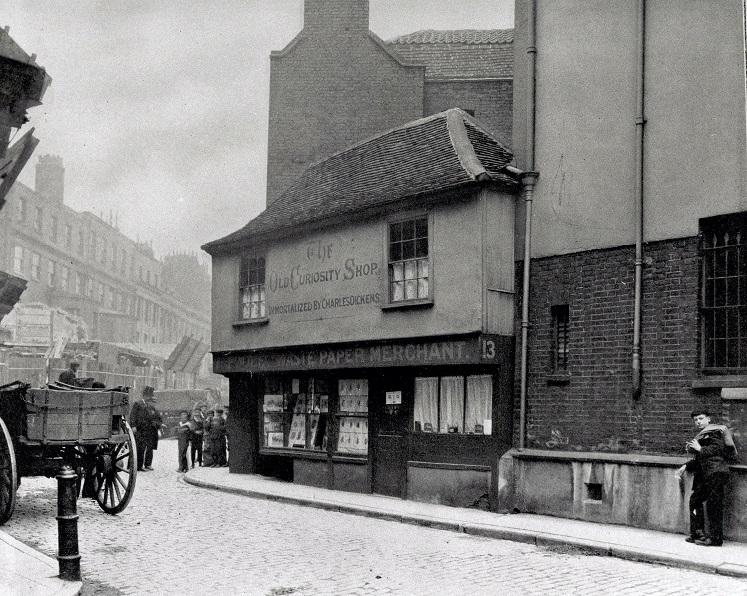
In July 1907, the shop received its next threat when it was announced in the Manchester Evening News that it was to be demolished and replaced with new office buildings. However, it appears these plans never transpired and instead the building was put up for auction in 1908. When the bids did not go above £5,950, it was withdrawn from sale, perhaps saving it from destruction once again.
Amongst this tourism continued unabated. The Bystander in August 1910 reported that, for the price of threepence, the proprietor would admit you to the upper story to see “Little Nell’s room”. However, the reporter found the experience uninspiring as little thought had been put into the presentation of the room, which was “full of lumber”. When the reporter went downstairs to complain, the host simply said that it “didn’t pay to have people coming there to inspect the premises”.
If it does not pay a man to show you nothing for threepence, what is your own profit on the deal worked out to five decimal places I should rather like to have this gentleman’s idea of a really remunerative enterprise.
– The Bystander, August 1910
In 1923, a Mr J A Phillips stepped on the scene as the new owner of the Old Curiosity Shop, which he promised to keep as a trove of curios. However, his fortunes with the shop were not fruitful. In January 1925, when it narrowly escaped destruction by fire, the building was reported as having been empty since December with a sign offering it to be let out to lease. In July 1929, Ireland’s Saturday Night newspaper describes it as being inhabited by a “jobbing tailor” and still attracting much attention from American tourists.
As we move into the mid 20th century, the Old Curiosity Shop overcomes further structural concerns in 1931 and then damage from World War II bombing which forced it to have its front shored up. It remained as a shop, most recently a shoe shop, until the COVID-19 pandemic.
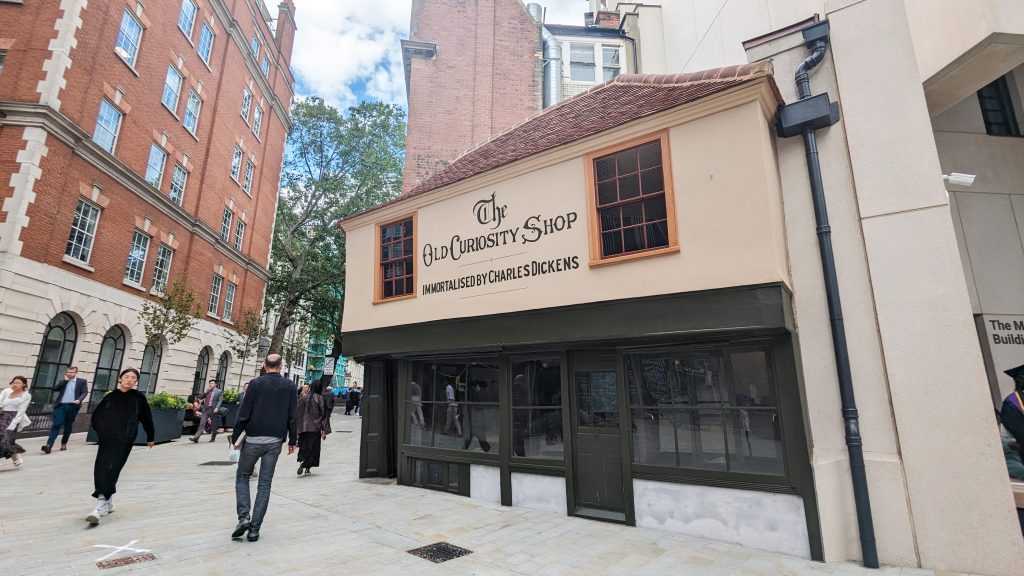
Now under LSE ownership, we recently finished work to ensure that the building is structurally stable and watertight. Working closely with Westminster Council Conservation Officer and Historic England, we have brought back the 19th century colour scheme based on historic evidence and recommendations from a historic paint analyst.
Newspaper quotes were sourced using the British Newspaper Archive



